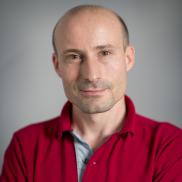Presentation
Developmental Brain Disorders Laboratory
Since his academic training, Vincent Cantagrel has been fascinated by two aspects: the molecular basis of brain development and genetic disease modeling. During his PhD, he used human genetics approaches to identify new gene defects causing intellectual disability and brain malformation. Then, during a 6 years postdoctoral training in the lab of Pr. J. Gleeson (UCSD; California), he worked on modeling pediatric cerebellar disorders using multiple approaches, based on mouse, zebrafish and even yeast. After joining, the Imagine institute in Paris in 2014, he could start his own group working on this topic.He has a strong interest in diseases caused by defects involving metabolic pathway (e.g., Protein glycosylation defect) or defects in key factors needed for cerebellar development (e.g., Cell specification factor). For him, these investigations have a strong potential to contribute to the basic understanding of human brain development, while providing direct translation for improved diagnosis of genetic disease and hints to improve treatments and patient care.
Over the past 10 years, our purpose has been to gain insight into the mechanisms leading to DBD. Thanks to our close links with the departments of Genetics, Neurology, Neuroradiology, Pediatrics and Child Psychiatrics at Necker as well as several reference centers, an ever-expanding collection of patients with unsolved neurodevelopmental diseases is being recruited. These patients are the corner stone of our studies. In addition, the local environment and context are both extremely relevant and efficient, with access to crucial platforms and core facilities for research including genomics, single-cell, imaging, induced pluripotent stem cells (iPSCs), bioinformatics, and animal models (mouse, and zebrafish). Lastly, our work relies on strong national and international collaborations with laboratories providing expertise in neurobiology, glycobiology, electrophysiology and bioinformatic analyses. The lab activities can be separated into three topics with a lot of cross-talks between each: (1) human genetic research projects; (2) basic science research projects and (3) transfer of knowledge to the diagnostic lab. The first topic is dedicated to the identification of new genetic defects involved in DBD with direct consequences on patients’ molecular diagnosis. The second aims to better understand normal brain development by dissecting disease mechanisms. For this aim, we focused mostly on DBD with structural cerebellar defect (SCD) to develop our own models. The last topic includes the development of improved diagnosis strategies using new sequencing or bioinformatic approaches.
...
Resources & publications
-
 2019Journal (source)Elife
2019Journal (source)ElifeHigh N-glycan multiplicity is critical for neuronal adhesion and sensitizes t...
-
 2019Journal (source)Brain
2019Journal (source)BrainBiallelic mutations in neurofascin cause neurodevelopmental impairment and pe...
-
 2019Journal (source)Brain
2019Journal (source)BrainDe novo mutation screening in childhood-onset cerebellar atrophy identifies g...
-
 2017Journal (source)Orphanet J Rare Dis
2017Journal (source)Orphanet J Rare DisUtility of whole exome sequencing for the early diagnosis of pediatric-onset ...
-
 2020Journal (source)Am. J. Hum. Genet.
2020Journal (source)Am. J. Hum. Genet.Opposite Modulation of RAC1 by Mutations in TRIO Is Associated with Distinct,...
-
 2018Journal (source)Hum Mutat
2018Journal (source)Hum MutatGenotype-phenotype correlations in individuals with pathogenic RERE variants.
-
 2020Journal (source)Nat Commun
2020Journal (source)Nat CommunMINPP1 prevents intracellular accumulation of the chelator inositol hexakisph...
-
 2021Journal (source)Blood
2021Journal (source)BloodInherited glycosylphosphatidylinositol defects cause the rare Emm-negative bl...
-
 2016Journal (source)Am J Hum Genet
2016Journal (source)Am J Hum GenetDisruption of POGZ Is Associated with Intellectual Disability and Autism Spec...
-
 2015Journal (source)Nat Genet
2015Journal (source)Nat GenetBiallelic mutations in SNX14 cause a syndromic form of cerebellar atrophy and...
-
 2013Journal (source)Cell
2013Journal (source)CellAMPD2 regulates GTP synthesis and is mutated in a potentially treatable neuro...
-
 2014Journal (source)Cell
2014Journal (source)CellCLP1 founder mutation links tRNA splicing and maturation to cerebellar develo...
-
 2015Journal (source)Eur J Hum Genet
2015Journal (source)Eur J Hum GenetIdentification of a novel ARL13B variant in a Joubert syndrome-affected patie...
-
 2021Journal (source)Nat Commun
2021Journal (source)Nat CommunLoss of function mutations in GEMIN5 cause a neurodevelopmental disorder.
-
 Journal (source)Nature Communications
Journal (source)Nature CommunicationsMINPP1 prevents intracellular accumulation of the chelator inositol hexakisph...
-
 2022Journal (source)Am J Hum Genet
2022Journal (source)Am J Hum GenetRecessive PRDM13 mutations cause fatal perinatal brainstem dysfunction with c...

